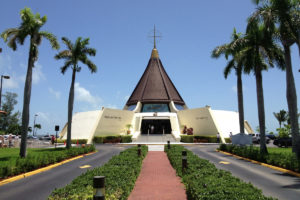 LA CARIDAD DEL COBRE, FOR CUBANS SYMBOL OF RECONCILIATION AND HARMONY.
LA CARIDAD DEL COBRE, FOR CUBANS SYMBOL OF RECONCILIATION AND HARMONY.
In the prayer to Our Lady of Charity of the Copper, placed by Pope Francis on the pilgrimage to the National Shrine, the Mother of Christ is asked, “she came to visit our town, and she wanted to stay with us as Mother and Lady of Cuba, throughout his pilgrimage through the paths of history. ”
In the same sentence, the appeals to the Charity of Copper, or to the Patron Saint of Cuba, are replaced, and she is called, with all property, “Mother of all Cubans”, “sign of hope and center of fraternal communion”.
Then, those who are inside and outside the Island are alluded to, and the Virgin is asked to intercede for us, “with your motherly heart”. It is also asked that we increase our faith, enliven hope, increase and strengthen love in us.
Later it is read, in keeping with the maternal spirit of the Patron Saint of Cuba: “It protects our families, protects young people and children, comforts those who suffer”.
To conclude the prayer, the Virgin is invoked as the Mother of reconciliation, and she is asked to gather her people dispersed throughout the world, and make the Cuban nation a home of brothers and sisters.
The mentions to the Charity of the Copper, as Mother of all the Cubans, are related to a long tradition that goes back to the first appearance, in 1612, in the Bay of Nipe, to three very humble slaves, of black and Indian race .
According to tradition, the image of the Virgin with the Child Jesus in her arms – the same image that today is the object of veneration for the Cubans – floated up on a board, where the phrase I am the Virgin of the Charity.
Through religious syncretism, the Virgin of Charity retains her maternal aura. The Yorubas identified her with Oshún, the owner of copper, a protector of the women in labor, and a fame of charity and mercy. The Catholic Church also used the image on satin ribbons to protect pregnant women and in childbirth.
During the wars of independence of Cuba, the troops of the Liberation Army manifested great devotion to the Virgin of Charity and entrusted themselves to it. Today, people who visit the Sanctuary often return to their homes with tiny copper stones. It is said that those who own them have a special protection for themselves and their families.
LA CARIDAD DEL COBRE, PARA LOS CUBANOS SÍMBOLO DE RECONCILIACIÓN Y ARMONÍA.
En la oración a la Virgen de la Caridad del Cobre, colocada por el Papa Francisco en la peregrinación al Santuario Nacional, se ruega a la Madre de Cristo, que “vino a visitar nuestro pueblo, y quiso quedarse con nosotros como Madre y Señora de Cuba, a lo largo de su peregrinar por los caminos de la historia”.
En esa misma oración, se sustituyen las apelaciones a la Caridad de Cobre, o a la Patrona de Cuba, y se la llama, con toda propiedad, “Madre de todos los cubanos”, “signo de esperanza y centro de comunión fraterna”.
Luego, se alude a los que están dentro y fuera de la Isla, y se le pide a la Virgen que interceda por nosotros, “con tu corazón maternal”. También se pide que acreciente nuestra fe, avive la esperanza, aumente y fortalezca en nosotros el amor.
Más adelante se lee, en consonancia con el espíritu maternal de la Patrona de Cuba: “Ampara nuestras familias, protege a los jóvenes y a los niños, consuela a los que sufren”.
Para concluir la oración, se apela a la Virgen como Madre de la reconciliación, y se le pide que reúna a su pueblo disperso por el mundo, y haga de la nación cubana un hogar de hermanos y hermanas.
Las menciones a la Caridad del Cobre, en tanto Madre de todos los cubanos, se relacionan con una larga tradición que se remonta a la primera aparición, en 1612, en la Bahía de Nipe, a tres esclavos muy humildes, de raza negra e india.
Según cuenta la tradición, la imagen de la Virgen con el Niño Jesús en brazos –la misma imagen que hoy es objeto de veneración por los cubanos– se acercaba flotando en una tabla, donde podía leerse la frase Yo soy la Virgen de la Caridad.
A través del sincretismo religioso, la Virgen de la Caridad conserva su aura maternal. Los yorubas la identificaron con Oshún que es la dueña del cobre, es protectora de las parturientas y tenía fama de caritativa y misericordiosa. La Iglesia católica también utilizó la imagen en cintas de raso para proteger a las mujeres embarazadas y en el parto.
Durante las guerras de independencia de Cuba, las tropas del Ejército Libertador manifestaban gran devoción por la Virgen de la Caridad y se encomendaban a ella. En la actualidad, las personas que visitan el Santuario suelen volver a sus hogares con diminutas piedras de cobre. Se dice que quienes las poseen cuentan con una especial protección para ellos y sus familias.
Agencies/CiberCuba/Joel del Río/Internet Photos/ Arnoldo Varona/ TheCubanHistory.com
THE CUBAN HISTORY, HOLLYWOOD.








